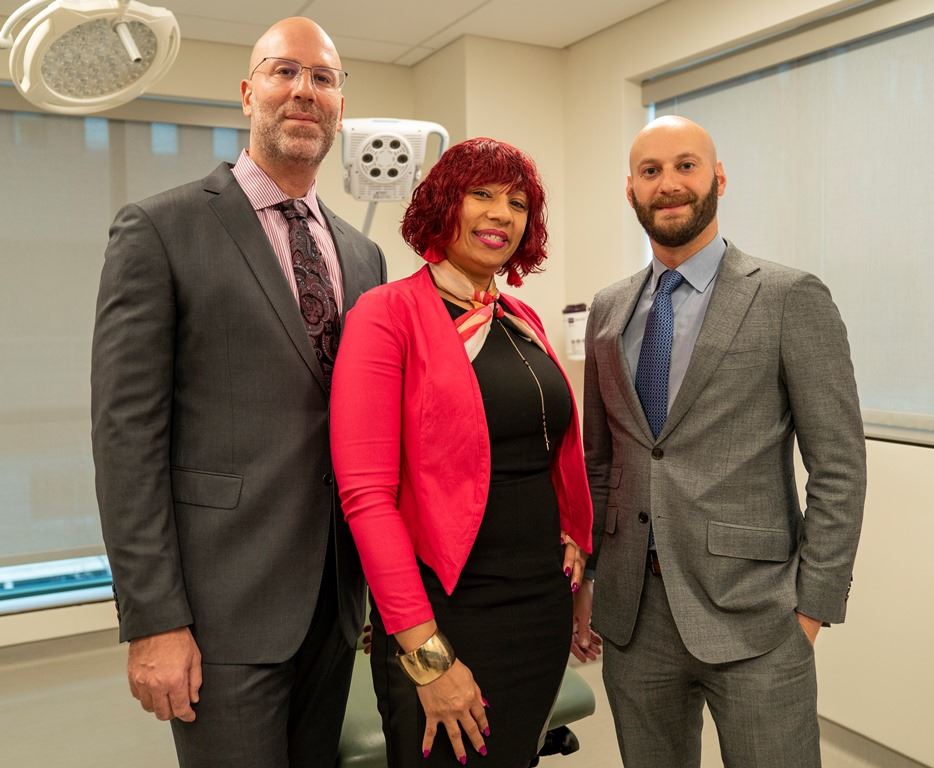"I feel like I woke up in plastic surgery heaven"

Thanks to Complex Microsurgery, a Breast Cancer Patient Is on the Road to Recovery
Tiashia Caldwell’s first mammogram resulted in devastating news: She had Stage I invasive cancer in her right breast. Tiashia, who works as a clinical service representative at the Stacy Goldstein Breast Cancer Center at Rutgers Cancer Institute of New Jersey, was all too familiar with the disease. “I watch patients endure their journey from their diagnosis all the way through their treatment,” she recalls. “This helped prepare me for the most difficult time in my life.”Fortunately, Tiashia was well-acquainted with top-notch surgeons at Rutgers Cancer Institute. She chose Lindsay Potdevin, MD, surgical oncologist at Rutgers Cancer Institute and Robert Wood Johnson University Hospital (RWJUH). Her options were to remove the right breast; have a lumpectomy (in which only the tumor is removed); or remove both breasts (a double mastectomy). “A lumpectomy would require radiation,” says Dr. Potdevin. “After treatment, Tiashia would continue to have mammograms, which can lead to anxiety.”
Tiashia chose the double mastectomy.
“Dr. Potdevin's recommendation to have reconstruction after the cancer surgery would give me a sense of normalcy as a woman in her early 40s,” she says.
Tiashia also had to decide what kind of reconstruction she would have after her cancer surgery. She met withJeremy Sinkin, MD, a plastic surgeon at RWJUH and Assistant Professor of Surgery in the Division of Plastic and Reconstructive Surgery at Rutgers Robert Wood Johnson Medical School. He told Tiashia that he could reconstruct her breasts using implants or abdominal tissue. Tiashia chose abdominal tissue.
“I heard that implants can shift inside the breast and become infected,” she says. “Plus, I wanted a more natural appearance.”
Another benefit of using abdominal tissue: It lasts a lifetime, whereas implants may need to be replaced if they break down.
Dr. Sinkin explained that after the double mastectomy, “tissue expanders,” or temporary implants, would be placed in her chest until it was known whether Tiashia would need chemotherapy, radiation or both. Another decision Tiashia had to make: whether to reduce the size of her breasts, which was 40DDD.
“I decided to reduce the size,” she recalls. “Dr. Sinkin views each patient as an individual. He wanted to do what would work best for me based on my lifestyle and preferences.”
RWJUH is known for its team approach to treatment.
“Our plastic surgeons, surgical oncologists and fellows, nurses, residents, physician assistants and office staff work together to deliver the best care,” says Richard L. Agag, MD, Chief of the Division of Plastic Surgery at Rutgers Robert Wood Johnson Medical School. “We also conduct research to refine our approach to surgery.” Every week, RWJUH oncology surgeons, radiation oncologists, medical oncologists and plastic surgeons meet to discuss patients' treatment plans and provide updates on medical research in their respective fields.
A Cutting-Edge Procedure
Tiashia had the double mastectomy with Dr. Potdevin with immediate placement of tissue expanders with Dr. Sinkin in April 2019. The tissue expanders were placed in front of her chest muscles, and biologic mesh was used to support the shape of the breasts. “This leads to less pain and a faster recovery time compared to the older method of placing the expanders behind the chest muscles,” says Dr. Sinkin. “It also enables the plastic surgeon to control the shape and size of the new breasts.” Th e purpose of the tissue expander is to preserve the breast skin and overall shape of the breast, and create a pocket for the abdominal tissue reconstruction.
Luckily, Tiashia’s pathology report showed that all of the cancer had been removed during surgery, so she didn’t need chemotherapy or radiation. Last September, she had the abdominal flap reconstruction surgery. As she did with her other procedures, she prayed before surgery. “I said, ‘God, thank you for giving gifts and talents to these surgeons to restore my body and health,’” she recalls. “I was 100 percent confident I was in great hands.”
The 10-hour procedure was performed by Drs. Sinkin and Agag. The surgeons removed the temporary implants, then removed skin, fat and blood vessels from the lower abdomen and reconnected the tissue to blood vessels in the chest.
This procedure, called the DIEP flap, is considered complex microsurgery.
“We combine the newest technology in reconstruction with the DIEP procedure,” says Dr. Agag.
To ensure the safety and reliability of the procedure, Drs. Sinkin and Agag have developed standardized protocols in the operating room and promote early, enhanced recovery.
Above and Beyond
After the surgery, Tiashia was surprised to discover that she was not in any pain. She spent three days in the hospital, then returned home. She had physical therapy to help strengthen muscles in her legs and arms. A visiting nurse assisted with wound care. In March 2020, she had another surgery. It involved nipple reconstruction and liposuction (fatty tissue from her side was used to help mold the breast tissue). “I’m excited because I’m near the end of my journey,” says Tiashia, who will have areola tattooing in the future. “My medical team went above and beyond to ensure I had the best care.”
Several months after her reconstruction surgery, Tiashia bumped into her surgical team at the hospital. “I said, ‘I feel like I woke up in plastic surgery heaven,’” she recalls, laughing.
On a more serious note, she says: “These physicians were heaven sent. I feel blessed to be in their care.”
For more information about the Plastic and Reconstructive Surgery program at Robert Wood Johnson University Hospital, please visit www.rwjbh.org/RWJUHPlasticSurgery.